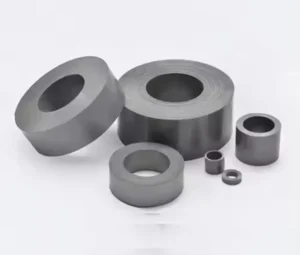
Introduction
Brief Overview of Magnet Ring Core
Magnet ring core, also known as toroidal core, is vital in modern electronics. Made from materials like ferrite or powdered iron, these ring-shaped magnetic cores efficiently direct and confine magnetic fields. Their unique shape enhances performance in electromagnetic devices by minimizing electromagnetic interference (EMI) and improving inductance properties.
Importance in Modern Electronics
What is a Magnet Ring Core?
Definition and Basic Structure
A magnet ring core, or toroidal core, is a donut-shaped magnetic component widely used in electronic and electrical applications. Its unique shape allows magnetic flux to flow in a closed loop, minimizing electromagnetic interference (EMI) and magnetic field leakage. This design boosts energy transfer efficiency and reduces losses, making toroidal cores highly effective in electromagnetic devices.
Common Materials Used
Magnet ring cores are typically made from a variety of materials, each chosen for their specific magnetic properties and performance characteristics:
Ferrite: Ferrite cores consist of ceramic-like materials with ferromagnetic properties, offering high magnetic permeability and low electrical conductivity. These characteristics make them ideal for reducing eddy current losses in high-frequency applications.
Powdered Iron: These cores are made from iron powder mixed with a binder, which provides a distributed air gap throughout the core. This material is known for its ability to handle higher magnetic flux densities and is commonly used in power inductors and transformers.
Amorphous Steel: This material, also known as metallic glass, features a non-crystalline structure that provides superior magnetic properties, such as reduced core losses and higher magnetic flux density. Amorphous steel cores are particularly effective in applications requiring high efficiency and compact designs.
By selecting the appropriate material, engineers can optimize the performance of magnet ring cores for specific applications, ensuring efficient and reliable operation in a wide range of electronic devices.
Types of Magnet Ring Core
Magnet ring cores, also known as toroidal cores, come in various types, each tailored to specific applications based on their magnetic properties and performance characteristics:
Ferrite Cores
Material: Ferrite cores are made from ceramic-like materials composed of iron oxide (Fe2O3) combined with other metallic oxides.
Properties: They offer high permeability and are effective at suppressing high-frequency electromagnetic interference (EMI). Ferrite cores are commonly used in applications requiring noise suppression, such as inductors and transformers in electronic circuits.
Powdered Iron Cores
Material: Powdered iron cores consist of iron powder mixed with a binder material to create a solid core.
Properties: They exhibit high magnetic permeability and can handle higher magnetic flux densities compared to ferrite cores. Powdered iron cores are suitable for applications where high efficiency and low core losses are required, such as in power transformers and inductors.
Amorphous and Nanocrystalline Cores
Material: Amorphous steel and nanocrystalline cores represent advanced magnetic materials known for their unique properties.
Amorphous Steel: It features a non-crystalline structure that provides low core losses and high magnetic flux density, making it ideal for high-efficiency transformers and inductors.
Nanocrystalline Cores: These cores combine nanoscale crystalline grains within an amorphous matrix, offering even lower core losses and higher permeability compared to amorphous steel. They are used in applications requiring extremely high efficiency and compact designs, such as in high-frequency power supplies and solar inverters.
Each type of magnet ring core is chosen for its specific magnetic and electrical characteristics to ensure optimal performance in a wide range of electronic and electrical applications.
Choosing the Right Magnet Ring Core
Factors to Consider
Frequency:
- High Frequency: For applications operating at high frequencies (above several kHz), cores with low eddy current losses and high magnetic permeability, such as ferrite cores, are preferable.
- Low Frequency: Lower frequency applications may benefit from cores that can handle higher magnetic flux densities, such as powdered iron cores.
Power Level:
- Low Power: Cores like ferrite can efficiently handle lower power levels due to their ability to suppress EMI and reduce losses.
- High Power: Powdered iron and advanced materials like amorphous or nanocrystalline cores are suitable for high-power applications due to their high magnetic flux density and low core losses.
Application Requirements:
- Noise Suppression: Ferrite cores excel in applications requiring electromagnetic interference (EMI) suppression, such as inductors in switching power supplies.
- Efficiency: Amorphous and nanocrystalline cores are ideal for applications demanding high efficiency, such as solar inverters and high-frequency transformers.
- Size and Weight: Advanced materials like nanocrystalline cores offer high efficiency in compact sizes, suitable for miniaturized electronic devices.
Comparison of Different Core Materials
Ferrite Cores:
- Advantages: High permeability, effective at suppressing EMI, and suitable for high-frequency applications.
- Disadvantages: Limited to lower power handling capacity compared to powdered iron and advanced materials.
Powdered Iron Cores:
- Advantages: High magnetic flux density, suitable for high-power applications with low core losses.
- Disadvantages: Larger and heavier compared to ferrite cores, less effective at high frequencies due to eddy currents.
Amorphous and Nanocrystalline Cores:
- Advantages: Extremely low core losses, high magnetic flux density, and excellent efficiency.
- Disadvantages: Higher cost compared to ferrite and powdered iron cores, more sensitive to mechanical stress.
By carefully evaluating these factors and understanding the properties of different core materials, engineers can make informed decisions to select the most suitable magnet ring core for their specific application requirements. This ensures optimal performance, efficiency, and reliability in electronic and electrical systems.